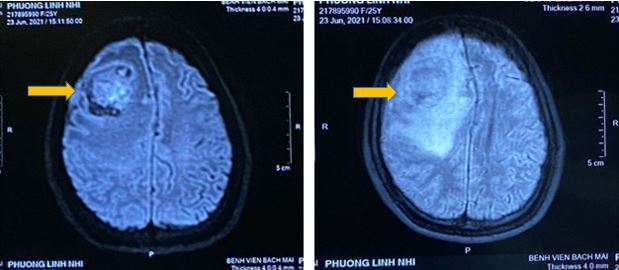Non-smoker, suddenly convulsing, 25-year-old girl went to the doctor to find out that lung cancer had metastasized to her brain
Sudden convulsions and weakness of the left half of the body, the young girl went to the doctor and was surprised when she was diagnosed with brain metastases left lung cancer, stage IV.
PLN patient (25 years old, Hanoi) 2 days before admission, had a generalized convulsion, about 3 minutes later, left half of the body was weak and numb. Apart from this symptom, she did not have fever, chest pain or difficulty breathing, nor did she cough up blood.
Being taken to Bach Mai Hospital by her family members, after the doctors ordered magnetic resonance imaging, she received a result that she had a brain tumor in the right frontal lobe.
The chest computed tomography scan showed an image of a 40x20mm left upper lobe tumor in the left lung. Mediastinal lymph node largest size 20x30mm.
 |
| Cranial magnetic resonance imaging showed a tumor in the left and right lobe of patient N. |
The patient was diagnosed with stage IV brain metastases left lung cancer. The pathological result was adenocarcinoma. Brain metastatic lesions cause compression leading to convulsions many times a day (despite antiepileptic treatment), plus bleeding in the tumor, so the patient is indicated for surgery to remove the brain tumor. emergency.
After that, the patient was transferred to the Nuclear Medicine and Oncology Center, Bach Mai Hospital. Here, the patient was treated with systemic chemotherapy PC-Bevacizumab (chemotherapy combined with targeted therapy).
According to CCII Doctor Vo Thi Huyen Trang, the patient was previously healthy, had no history of allergies, did not smoke, and did not find anything special about taking family history. The patient has incomplete paralysis of the left half of the body, muscle strength 4/5. The blood count tests, blood biochemistry, liver and kidney function, etc. are all normal. Cancer markers CEA and Cyfra were both elevated.
After one month of treatment, the patient was awake, no convulsions, no chest pain, no shortness of breath, no headache, the left hemiplegia gradually improved. After 3 months, the patient was stable and left hemiplegia completely.
Currently, after 6 months of treatment, the patient’s health is stable and normal activities. Left upper lobe tumor reduced in size to 13x14mm, no further brain damage appeared.
According to Assoc. Prof. Dr. Pham Cam Phuong – Director of the Center for Nuclear Medicine and Oncology, Bach Mai Hospital, non-small cell lung cancer is one of the most common cancers in Vietnam, ranking 2nd in terms of incidence. morbidity and mortality (after liver cancer). Patients often go to the hospital when they are in the late stage (stage III, IV).
Up to now, systemic treatment is the main treatment at this stage, including chemotherapy, symptomatic radiation therapy, and immunotherapy. Treatment selection and planning depends on the individual patient’s physical condition, stage, and histological type, as well as genetic mutation tests.
Doctors also emphasize, advanced non-small cell lung cancer is a malignancy with a poor prognosis. However, since there is individualized treatment for each patient with different genetic mutations, the response to chemotherapy, targeted therapy, and immunotherapy methods is different. With the application of these new advances, the patient’s survival time has been significantly extended and the side effects are acceptable.
Lung cancer in general and non-small cell lung cancer in particular are caused by different factors. Researchers are constantly looking at these factors to possibly prevent the risk of disease. Although there is no proven way to completely prevent this disease, taking some preventive measures as advised by a specialist can reduce your risk.
The most important way to prevent lung cancer is to avoid secondhand smoke. There have been many statistics, non-smokers have a very low risk of lung cancer. Smokers can reduce their risk of lung cancer by stopping smoking, but their risk of lung cancer will still be higher than that of never-smokers.
If lung abnormalities are detected early, it will increase the cure rate and prevent the progression of the disease into cancer. Therefore, it is necessary to perform periodic lung cancer screening, which can detect early signs of lung abnormalities as well as lung-related diseases, helping to detect and treat early. promptly avoid unfortunate things from happening.
N. Huyen
at Blogtuan.info – Source: infonet.vietnamnet.vn – Read the original article here



